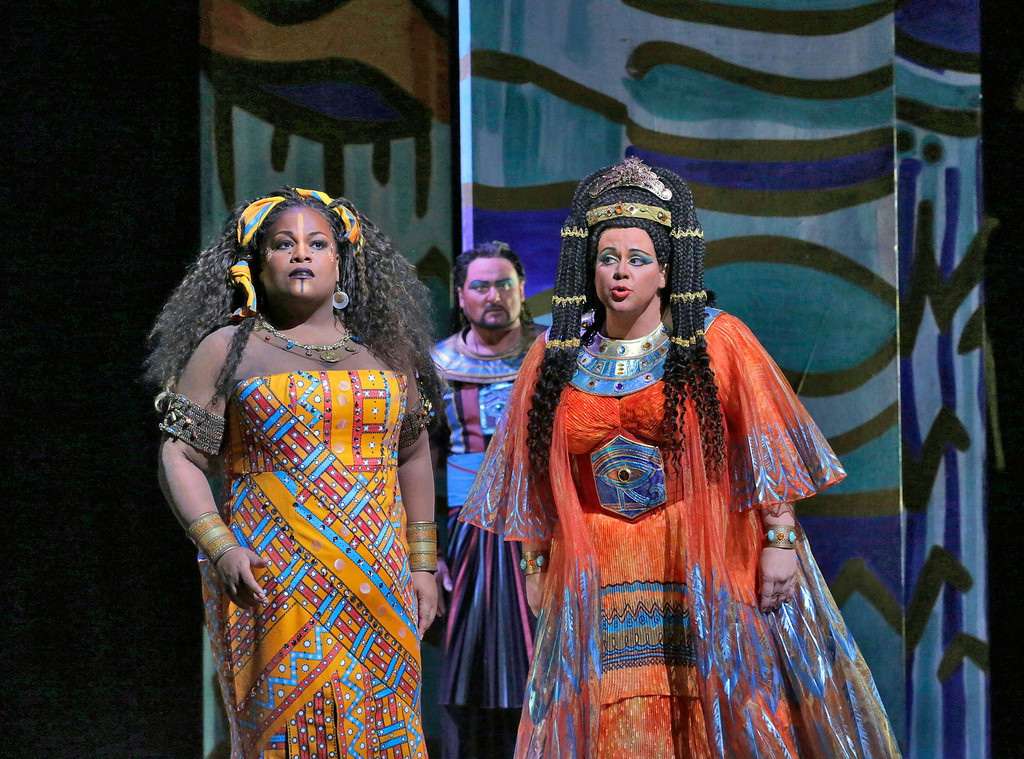|
Back
Well-sung Aida is lavish, garish San Diego
San Diego Civic Theater
04/20/2013 - & April 23, 26, 28, 2013
Giuseppe Verdi: Aida
Latonia Moore (Aida), Jill Grove (Amneris), Walter Fraccaro (Radames), Mark S. Doss (Amonasro), Reinhard Hagen (Ramfis), Ashraf Sewailam (King of Egypt), Greg Fedderly (Messenger), Priti Gandhi (High Priestess)
The San Diego Opera Orchestra & Chorus, Charles F. Prestinari (Chorus Master), Daniele Callegari (Conductor)
Andrew Sinclair (Director), Kenneth von Heidecke (Choreographer), Zandra Rhodes (Costume and Scenic Designer), Christopher Maravich (Lighting Designer), Steven Bryant (Wig and Makeup Designer)

(© Ken Howard/SD Opera)
Aida is one of those grand operas where the ticket-buyer can see how their dollars translate onstage, and San Diego Opera's latest production of the Giuseppe Verdi chestnut spares no expense.
The $2.1 million production that opened Saturday has more than 150 singers, dancers, choristers, trumpeters and supers onstage, another 71 musicians in the orchestra pit, nearly 300 costumes and more than 100 wigs and headpieces. But at times, Zandra Rhodes' stylized Egyptian costumes -- designed for Houston Grand Opera -- are so garish and gaudy, you want to close your eyes and just listen to the well-sung production instead.
You can't fault the cast, assembled by company General Director Ian Campbell, which features three singers making their company debuts in the principal roles.
As the Ethiopian princess Aida, American soprano Latonia Moore more than impressed with her creamy vocals. Her powerhouse voice, particularly in "Ritorna vincitor!," could easily fill the 3,000-seat San Diego Civic Theatre, but she also possesses a delicacy and beauty of tone, heard best in the finale, where her character has crawled into an underground tomb to die with Radames, the disgraced Egyptian general who loves her.
Also making his local debut is Italian tenor Walter Fraccaro as Radames. His opening aria "Celeste Aida" -- always the bane of tenors because it comes so early in the opera that they haven't had time to warm up their voices and it sits in the passagio between the head and chest voices -- came off a bit ragged and pushed. But by the second act, he was firmly in command with an easy top and round, rich quality to his voice. And as Amneris, the spurned Egyptian princess who is the third corner of this operatic love triangle, American dramatic mezzo Jill Grove is solid and passionate in her performance. Her signature aria "L'abborrita rivale" was performed with technical near-perfection except on its final note.
They've got strong support from Canadian-American bass-baritone Mark S. Doss as the Ethiopian king Amonasro and particularly German bass Reinhard Hagen as Ramfis, the Egyptian high priest. And the San Diego Opera chorus, with Indian-American soprano Priti Gandhi as the offstage Priestess, sounded magnificent. Another newcomer, Italian conductor Daniele Callegari, put the San Diego Symphony through a spirited performance of Verdi's three-hour score. The sound was full and clear, though at times it drowned out Grove's vocals.
But back to those costumes. Rhodes -- a British-born fashion designer who came of age in the 1980s and never left her flashy, day-glo palette behind -- bathes the stage in riot of color (she also designed the painted backdrops). Audiences will either love or hate the highly stylized look of the production, which includes temple guards in gold lame hoop skirts, priests in spacesuit-like floating pod dresses, Egyptian men in electric blue skirts and female dancers with Balinese-style long plastic fingernails. But I can't see anyone loving the stereotypical African native costumes created for the Ethiopians. The cringe-worthy ensembles -- think Rafiki the baboon from Disney's The Lion King meets the tribal warriors in the 1933 film "King Kong" -- have no basis in ancient history and Amonasro looks more like a homeless man in dreadlocks than an African king. The costumes for Moore and Grove are particularly unflattering. Combined with gargantuan wigs, the women look like mobile mountains. And many of the men in the cast, who wear bright blue eye makeup, look like drag queens.
With that being said, there is one inspired element to Rhodes' production -- an ingenious blue elephant "puppet" operated by five men. It's the only thing about the triumphal march scene in the second act that's worth remembering.
Director Andrew Sinclair brings some fresh and good ideas to the plate for this Aida -- a good thing, since San Diego Opera produces the Verdi favorite about every five years -- but the triumphal march is not one of them. The victory parade, when Radames returns from battle in Ethiopia with the spoils of war, is always a showcase scene, with a seemingly endless pageant of soldiers carrying treasures, weapons, prisoners and seized animals. In this production, the march is replaced by a long and repetitive dance. Kenneth von Heidecke's choreography for 16 athletic dancers is good, but the deletion of the march is disappointing. A new and inspired touch is Sinclair's decision to replace the first temple scene -- where Radames is usually anointed and dressed for battle -- with a human sacrifice (a slave's throat is slit and Radames' sword is bathed in his blood). And when Amneris realizes that Radames will be sentenced to death, she is stalked by several men wearing masks of Anubis, the jackal-headed god of the underworld.
Opera is all about spectacle, and you can say that Rhodes' Aida is spectacular. In the big chorus scenes, it's eye-popping to say the least. But the incongruous mix of styles, colors and cultures distract from the beauty and tragedy of the opera and its lovely score.
Pam Kragen
|